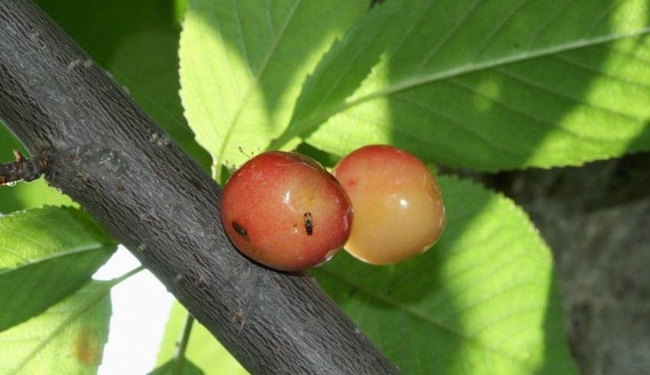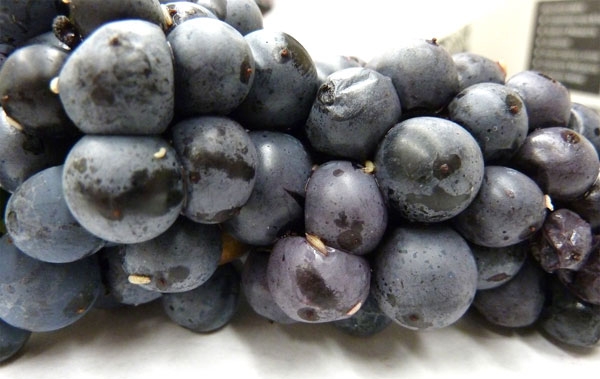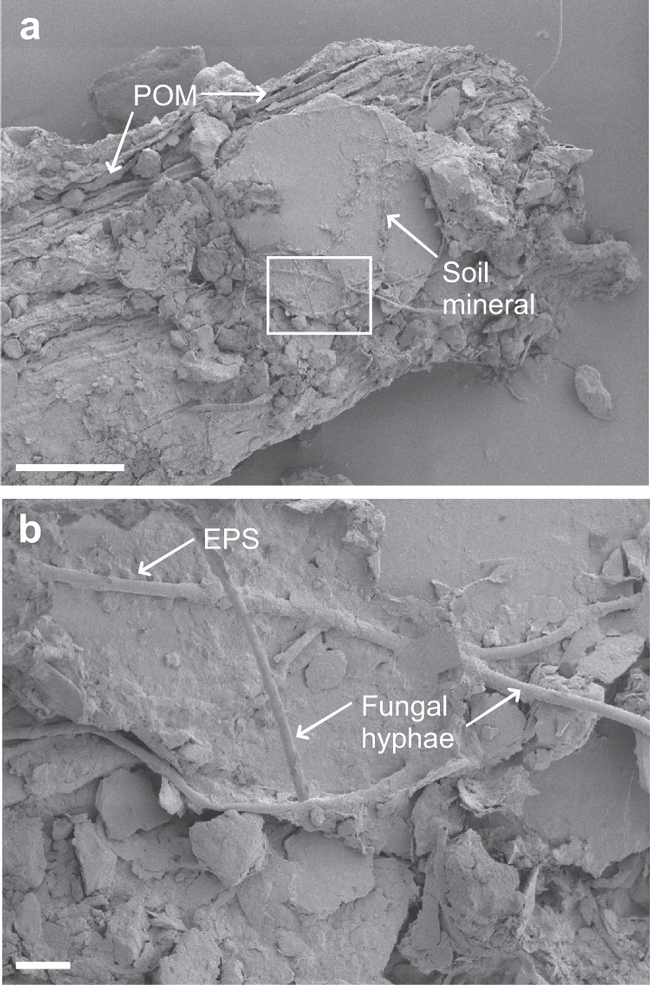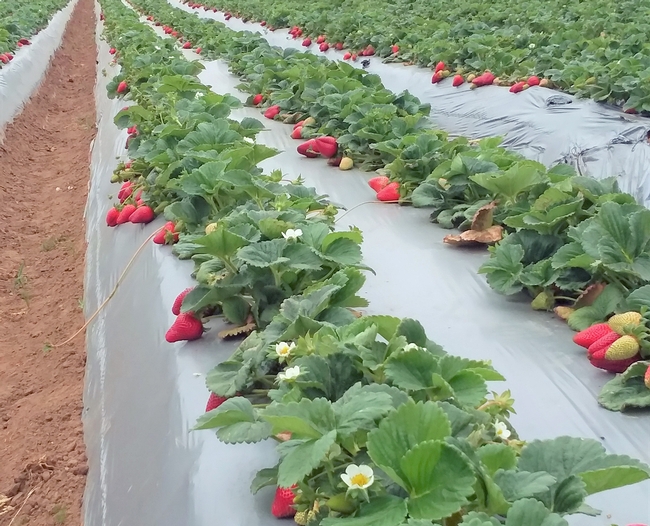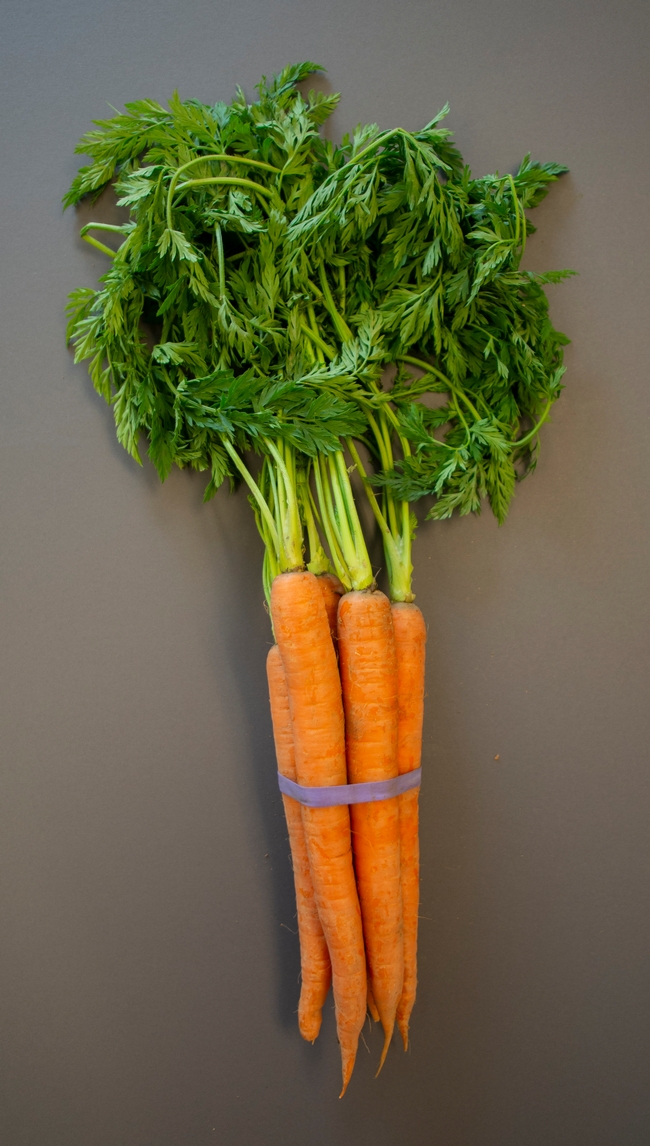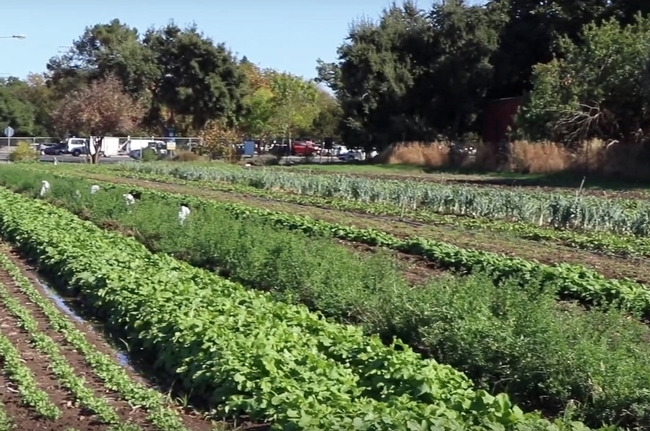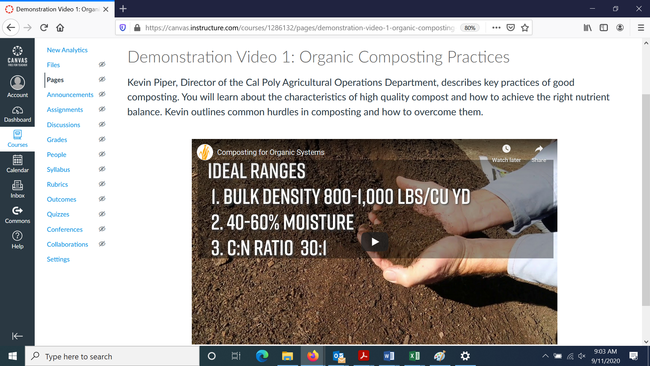Please join us for a weekly lunchtime seminar series. Each week we'll be joined by a guest speaker for a 30-minute presentation followed by questions from the listeners and more general discussion.
The Zoom link will be the same each week. No pre-registration required.
Meeting link:https://ucanr.zoom.us/j/95260378391?pwd=TXNTNmtNalo5TzY0bjdISEszeXRXUT09
*The presentation (not the Q and A discussion) will be recorded and made available.
Habrá traducción al Español
|
Date
|
Topic
|
|
Tuesday, January 24
|
Nitrogen Mineralization from Organic Fertilizers and Composts
Joji Muramoto, Organic Production Specialist, UC Santa Cruz
|
|
Tuesday, January 31
|
Tools and Approaches for Assessing and Improving Irrigation Efficiency on the Farm
Michael Cahn, Irrigation and Water Resource Farm Advisor, UCCE
|
|
Tuesday, February 7
|
Organic Management of Nematodes
Philip Waisen, Vegetable Crops Advisor, UCCE
|
|
Tuesday, February 14
|
How to Identify and Scout for Insect Pests
Alejandro del Poso, Assistant Professor of Entomology, Applied Insect Ecology - Turfgrass and Ornamentals, Virginia Tech University
|
|
Tuesday, February 21
|
Why, How and When to Choose Between Open-pollinated, Hybrid, and Land-race seeds?
Charlie Brummer, Director and Professor, Center for Plant Breeding, UC Davis
|
|
Tuesday, February 28
|
Management of Soilborne Plant Pathogens with Organic Amendments
Amisha Poret-Peterson, USDA-ARS, Davis
|
|
Tuesday, March 7
|
Biology and Management of Thrips and the Diseases They Spread
Daniel Hasegawa, USDA-ARS, Salinas
|
|
Tuesday, March 14
|
Weed Management on Small farms and in Organic Production Systems
Darryl Wong, Executive Director, Center for Agroecology & Sustainable Food Systems, UC Santa Cruz
|
|
Tuesday, March 21
|
Recruiting Owls and Raptors for Pest Management
Breanna Martinico, Human-Wildlife Interactions Farm Advisor, UCCE
|
Questions? Contact Margaret Lloyd mglloyd@ucanr.edu, Aparna Gazula agazula@ucanr.edu or Lucy Diekmann lodiekmann@ucanr.edu, Hung Kim Doan hkdoan@ucanr.edu
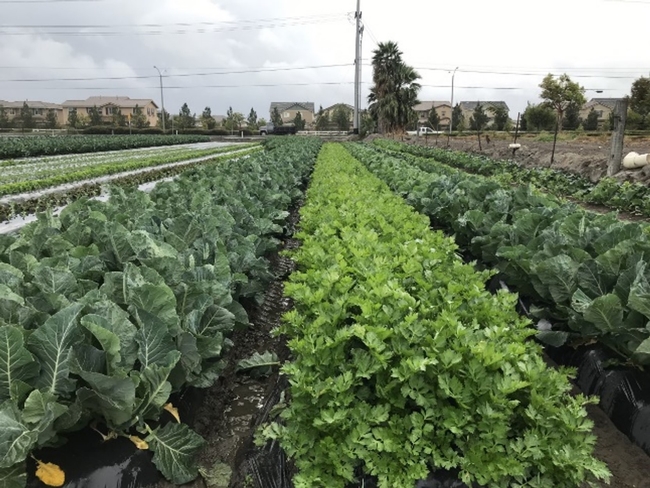
Veggie
Posted on
Thursday, February 9, 2023 at
7:00 AM
Focus Area Tags: Agriculture
A recent paper shows that a food-grade coating can successfully reduce the damage of cherry fruit fly on cherries. This has implications for control of olive fruit fly, spotted-wing drosophila (on blueberry and other bush berries), Mediterranean fruit fly and other tephritid flies. Read on:
Evaluation of Organic, Food-Grade Hydrophobic Coatings for Suppressing Oviposition and Increasing Mortality of Western Cherry Fruit Fly (Diptera: Tephritidae)
Abstract
To reduce risks and concerns of extensive insecticide use for controlling tephritid fruit flies, non or less toxic organic management options to the use of insecticides alone for fly control are needed . One such option is the use of physical or chemical barriers sprayed on fruit to protect fruit from fly attack. Surround wettable powder (kaolin) is the major organic barrier that has been developed that protects fruit (against sunburn) and deters insects. However, Surround has not been adopted to any large extent by growers for use against fruit flies due in part to the white residue it forms on fruit. A product that protects fruit while leaving no visible residue on fruit surfaces might be more acceptable for use.
Recently, the product HydroShield (original formulation; Cuticle Supplement), a nonwax organic food-grade hydrophobic coating that simulates plant cuticles, was developed that protects cherries from water-induced cracking . Unlike Surround, HydroShield forms an invisible (to human eyes) coating on cherries. HydroShield incidentally also helps protect fruit against attack by insects, specifically Drosophila suzukii (Matsumura) (Diptera: Drosophilidae), reducing oviposition by this fly in Sweetheart cherries.
Newer organic options for protecting fruit from tephritid fruit fly attack are needed to reduce extensive insecticide use. Here, we evaluated organic, food-grade hydrophobic coatings that help protect sweet cherries (Prunus avium L.) from water-induced cracking for suppressing attack on cherries by western cherry fruit fly, Rhagoletis indifferens Curran (Diptera: Tephtitidae), as well as for their effects on fly mortality. Three formulations of coatings called HydroShield 13.20, 13.22, and 13.28 that form invisible elastic barriers on cherries and that consist of complex carbohydrates, fatty acids and occlusive agents, solvents, emulsifiers, emollients, surfactants, and other ingredients were tested. In the laboratory, fly visits on and oviposition in HydroShield-coated cherries were 66.1–92.8% and 59.1–99.5% lower, respectively, than in controls. The mean number of dead female flies exposed to HydroShield-coated cherries was 69.4–94.6% greater than of females exposed to control cherries. In the field, three sprays of HydroShield 13.22 and 13.20 on sweet cherry trees in 2020, when fly densities were high, reduced larval infestations in cherries by 32.1% and 31.8%, respectively. In the field in 2021, when fly densities were lower, three sprays of HydroShield 13.22 and 13.28 reduced infestations in cherries by 90.5% and 86.8%, respectively, but sprays also reduced cherry size and toughened cherries. HydroShield formulations show promise in protecting sweet cherry from attack by R. indifferens, but further testing is needed to improve formulations so that they suppress fly oviposition without affecting cherry quality.
https://academic.oup.com/ee/advance-article/doi/10.1093/ee/nvac033/6590995?login=false
Adult drosophila laying eggs
Maggots doing their thing on blueberry
Posted on
Tuesday, July 12, 2022 at
10:48 AM
Focus Area Tags: Agriculture
For quite some time, farmers and researchers have been focusing on how to bind carbon to soil. Doing so makes food crops more nutritious and increases yields.
However, because carbon is converted into CO2 when it enters the atmosphere, there is a significant climate benefit to capturing carbon in soil as well.
Too much carbon finds its way into the atmosphere. Should we fail to reverse this unfortunate trend, we will fail to achieve the Paris Agreement's goal of reducing greenhouse gas emissions by 40 percent by 2030, according to CONCITO, Denmark's Green Think Tank.
As such, it is important to find new ways of sequestering carbon in soil. This is where a team of researchers from the University of Copenhagen and the Technical University of Munich enter the picture.
In their new study, they argue for the potential of simply allowing agricultural crop residues to rot in fields.
"Fragments of dead plants in soil are often considered as fast food for microbes and fungi. But our study demonstrates that plant residues actually play a more significant role in forming and sequestering carbon in soil than what was once thought," explains Kristina Witzgall, a PhD Candidate at the Technical University of Munich and the study's lead author.
In the past, researchers mainly focused on carbon storage in the surfaces of minerals like clay. However, the new results demonstrate that plant residues themselves have the ability to store carbon, and perhaps for longer than once supposed.
This is because a number of important processes take place directly upon the surface of these plant remains.
"We demonstrate that agricultural crop residues are absolutely central to carbon storage and that we should use them in a much more calculated way in the future. Plant residues make it possible for carbon, in all likelihood, to be stored in soil for roughly four times longer than if they aren't added," states Carsten Müller, the study's co-author and an associate professor at the University of Copenhagen's Department of Geosciences and Natural Resource Management.
Fungi and soil clumps store carbon
To understand how plant residue sequesters carbon, it is important to know that plant tissue already contains carbon absorbed by plants from the atmosphere via photosynthesis. As plant matter rots, carbon can be transferred into the soil in a number of ways.
"Our analysis shows that plant residues, as they interact with fungi, play a surprisingly large role in carbon storage. As fungi fling their white strands around plant fragments, they 'glue' them together with the soil. The fungi then consume the carbon found in the plant matter. In doing so, they store carbon in the soil," explains Carsten Müller.
In addition to fungi, the researchers' analyses also show that the soil structure itself determines the amount of carbon that can be stored.
"When soil is glued together in large hard lumps by the stickiness of bacteria and fungi, plant residues are shielded from being consumed by bacteria and fungi, which would otherwise eat and then emit some of the carbon as CO2 into the atmosphere," says Kristina Witzgall.
She goes on to say that while carbon can be stored in soil from weeks to a thousand years, the usual duration is about 50 years.
Reducing CO2 in the future
The method of leaving crop residues like stalks, stubble and leaves to rot is not unheard of when it comes to enhancing agricultural land.
However, deploying rotten plants as a tool to store carbon should be taken more seriously and considered as a strategy to be expanded, according to the researchers behind the new study.
"The fertile and climate-friendly agricultural lands of the future should use crop residue as a way of sequestering carbon. We will also be conducting experiments where we add rotten plant matter deeper into the soil, which will allow carbon to be stored for even longer periods of time," says Carsten Müller.
If we work to create better conditions for carbon sequestration in soil, we could store between 0.8 and 1.5 gigatonnes of carbon annually. By comparison, the world's population has emitted 4.9 gigatonnes of carbon per year over the past 10 years.
All in all, the researchers' findings can be used to understand the important role and promise of crop residues for carbon storage in the future.
However, Kristina Witzgall goes on to say that a variety of initiatives are needed to increase carbon sequestration, such as crops that can absorb atmospheric carbon and the restoration of lost forests.
Read the whole story: https://www.nature.com/articles/s41467-021-24192-8
Images:
Scanning electron microscopy (SEM) images of the interface of plant litter (POM) and soil minerals, where soil minerals are (a) attached to the litter surface (scale bar = 100 µm) and (b) enmeshed with fungal hyphae and extracellular polymeric substances (EPS; scale bar = 10 µm). Similar images were obtained from at least 10 independent locations in each soil texture.
Posted on
Wednesday, July 21, 2021 at
8:09 AM
Focus Area Tags: Agriculture
Organic farming continues to expand in California and now includes more than 360 commodities, according to a new University of California report. The number of organic growers, acreage and farm gate sales revenue is reported by commodity, county, region and statewide in the new “Statistical Review of California Organic Agriculture, 2013-2016.” The data are collected from farms that register as organic with the California Department of Food and Agriculture.
“This report highlights the incredible diversity and abundance of organic crops being grown across so many different geographic regions in the state, which reflects California's leading role in this production sector,” said Houston Wilson, director of the new UC Organic Agriculture Institute.
“Dairies continue to lead by value of organic production,” said Rachael Goodhue, UC Davis professor of agricultural and resource economics and coauthor of the report.
The number of organic growers in California jumped from 2,089 in 2013 to 3,108 in 2016. The top 10 organic commodities for sales value in 2016 were cow milk, strawberries, carrots, wine grapes, table grapes, sweet potatoes, almonds, raspberries, salad mix, and chicken eggs.
“This review is critical to understand the changes in the fast-growing organic agriculture sector in the state where more than 50% of the nation's organic vegetables and fruits are produced,” said Joji Muramoto, UC Cooperative Extension organic production specialist at UC Santa Cruz and coauthor of the report. “It provides statistics of all organic commodities produced across the state as well as at county level. This is the primary reference to learn about the size, diversity, and trends of organic agriculture in the state.”
Organic strawberries ranked second in California organic commodities with $202 million in sales value in 2016. Photo by Joji Muramoto
In 2016, California organic sales were $3.1 billion with an average of $1 million in sales per farm, but revenue varied widely among farms. For example, San Diego County had the most organic growers (313) in 2016, but Kern County's 47 organic farmers earned the most in total organic sales: $381 million on 49,727 acres, excluding pasture and rangeland, according to Muramoto.
“The average gross income of organic farms increased 14-fold from 1994 to 2016, reaching $1 million in 2016,” Muramoto said. “However, 77% of growers received less than $500,000 per year and 22% of growers who made $500,000 or more per year received 94% of the total gross sales, showing the income concentration among organic growers in the state.”
The statistical review of California's organic agriculture had been published since 1998 by the late Karen Klonsky, UC Cooperative Extension specialist, and her team after statistics for organic agriculture became available in 1992 as a result of the California Organic Food Act.
The last report published by Klonsky, who passed away in 2018, covered 2009-2012. All previous organic agriculture statistics reports can be accessed at https://aic.ucdavis.edu/research1/organic.html.
“This report of organic data continues the series of studies initiated by Karen Klonsky many years ago. It contains vital summary information for industry and policymakers as well as researchers,” said Goodhue.
Since the data collection began in 1994, the number of organic growers in California has increased 2.8-fold to 3,109 and the farm-level sales 40-fold to $3.1 billion in 2016.
Organic carrots ranked third in sales value in California at $161 million in 2016.
“Accurate annual data on California organic crop production, acreage and value is critical to understanding the scale and scope of this growing agricultural sector,” said Wilson. “As the UC Organic Agriculture Institute begins to develop research and extension programs, it is important that we have a reliable way to assess the extent and geography of organic production as well as track changes over time.”
Muramoto, who became the UC Cooperative Extension organic production specialist in 2019, collaborated with Goodhue, Daniel Sumner, director of the UC Agricultural Issues Center and UC Davis professor of agricultural and resource economics; and UC Davis graduate student Hanlin Wei to produce the latest statistical review of California's organic agriculture.
More recent years are not included because the data collected by CDFA changed in 2017 and again in 2019 so they are not comparable to the data in this report. The full report can be downloaded from the UC Agricultural Issues Center website at https://aic.ucdavis.edu/2020/10/06/statistical-review-of-californias-organic-agriculture-by-wei-goodhue-muramoto-and-sumner.
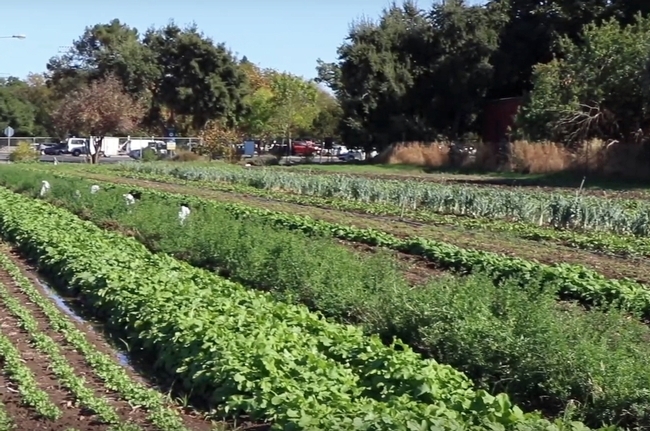
organic farm
Posted on
Wednesday, January 6, 2021 at
6:56 AM
Focus Area Tags: Agriculture
New online training is designed for beginning farmers and those or transitioning to organic practices. Photo courtesy of UC SAREP
Farmers who want to learn organic production practices for California specialty crops can now get training at their convenience on their own computers. The organic farming training is designed by the University of California Sustainable Agriculture Research and Education Program, Organic Farming Research Foundation and California Polytechnic State University in San Luis Obispo.
“This course includes information from the latest scientific research conducted by our University of California colleagues across the state, and boils it down into practical information for beginning or transitioning organic farmers of fruit, nuts, vegetables and other specialty crops,” said Sonja Brodt, UC SAREP academic coordinator for agriculture and environment.
The training program contains six learning modules: soil health, weed management, irrigation and water management, insect and mite pest management, disease management, and business management and marketing.
The training covers soil health, weed management, irrigation and water management, insect and mite pest management, disease management, and business management and marketing.
“We were able to draw on the expertise of 22 technical advisors, the majority of them from UC Cooperative Extension, UC campuses and Cal Poly San Luis Obispo, to ensure the scientific accuracy of the information provided,” Brodt said.
The program provides a combination of written content, videos and do-it-yourself exercises that allow students to follow along at their own pace and test their grasp of the knowledge. Farmers may read or view any parts of the course they choose, in any sequence. No certificate or credit is given at completion.
“While it was developed for California specialty crop farmers, the content is based on foundational principles that are relevant to all organic farmers and our hope is that growers across the U.S. find it to be a useful resource,” said Lauren Snyder, OFRF education & research program manager.
UC Davis Student Farm coordinator Raoul Adamchak discusses irrigation. To ensure the scientific accuracy of the information provided, the training draws on the expertise of 22 technical advisors, the majority of them from UC Cooperative Extension, UC campuses and Cal Poly San Luis Obispo.
The organic farming training is free. To obtain a link to the training, submit a request at https://ofrf.org/beginning-farmer-training-program.
Funding for this online training program was made possible by the U.S. Department of Agriculture's (USDA) Agricultural Marketing Service through grant AM170100XXXXG011. Its contents are solely the responsibility of the authors and do not necessarily represent the official views of the USDA.
Posted on
Monday, September 28, 2020 at
7:09 AM
- Author:
Pam Kan-Rice
- Author:
Vickie Lowell
Focus Area Tags: Agriculture



